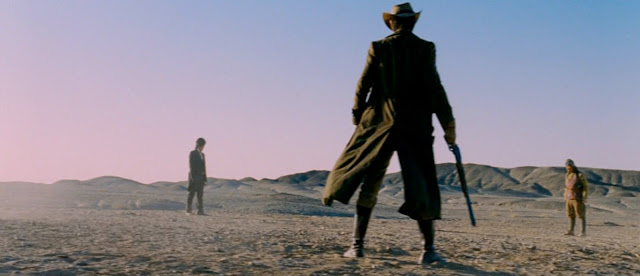International Wester Films: The Good, The Bad, The Weird (2008)
Korean director Kim Jee-woon's "The Good, The Bad, The Weird" transposes the Western to Manchuria in the late 1930s, taking part of the name of Sergio Leone's classic Spaghetti Western"The Good, the Bad and the Ugly," but also its basic plot, and also the concept of a foreign Western named after food (the director asked that this be called a Kimchi Western.)
He also borrows some Leone's themes, especially that of the unstable partnership. This film is full of impromtu allegiances that quickly fall apart. It is, after all, the story of three unprincipled men each looking to possess a MacGuffin (in this case, a treasure map). The men are: The Good, a bounty hunter in cowboy garb played by Jung Woo-sung; The Bad, a grinning psychopath in a suit, played by Lee Byung-hun; and The Weird, a thief played by Song Kang-ho, who is starting to develop into an international movie star for his ability to play dim-seeming goofballs who prove to be surprisingly canny.
The film is a series of frenetic set pieces, from a bravura opening scene in which the three characters simultaneously assault a train to the yet-more-bavura climax, when our heroes have a shootout on horseback while simultaneously being pursued by Manchurian gangsters but also by the Japanese military, who finally just starts shelling them.
Jung Woo-sung is stolid and looks terrific spinning his rifle to reload it, but the film is really Lee Byung-hun and Song Kang-ho's. The former plays a type I mostly associate with Manga, the slightly foppish villain with peek-a-boo bangs and a penchant for cruelty. Lee often plays the role with a smirk, like being utterly awful is amusing to him, but there is an undercurrent of irritation, as though the whole of humanity were bothersome; he has no compunctions about killing enemies and allies alike when they get on his nerves.
Song Kang-ho, in the meanwhile, has put together a crazy quilt outfit that feels like some folk costume, with a leather flight cap and goggles constantly perched on his head, looking like those pointed hats Mongolians wear, along with a red leather vest and two shoulder holsters. He's the characetr who has most fully synthesized an Eastern and a Western look, and he's ostensibly the film's hero.
It's rare the camera leaves Song, and most of the film is him extricating himself from one situation or other, which he does both cleverly and clumsily (in one instance, he runs around with the top to a diving bell over his head, protecting him from bullets.) This is the sort of role Song excels at, because he seems so awkward and clueless that you really do worry for him.
But the film plays with this cleverly, as, if you're paying attention, Song's character is every bit as amoral as Lee's, if a bit more adorable. In fact, Song likely kills more people than Lee, and while he doesn't have Lee's sadism, he has a sociopath's lack of remorse or reflection.
But you'd have to really be paying attention, because, in the context of an action movie, he's just behaving the way character's in action movies behave. They kill at a moment's notice, without mercy, and then move on without guilt. We've come to expect this from our heroes, and so don't recognize it for what it is: psychopathic.
There's a twist based on this at the end, during a disastrous final gun duel that leads to a grim conclusion (that is undermined post-credits). Our heroes, it turns out, aren't really that heroic, and our villains, while still villainous, are also victims of villainy.
We should have seen it coming. We should have known these men were all amoral monsters. But to know that, we would have to believe it is also true of every action hero who likewise kills without hesitation, mercy, or reflection. All of them would have to be psychopaths,
Maybe all of them are.



Comments
Post a Comment